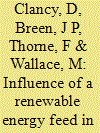| Srl | Item |
| 1 |
ID:
107631


|
|
|
|
|
| Publication |
2011.
|
| Summary/Abstract |
Biomass co-firing systems in power plants generate electric power by the simultaneous combustion of biomass and fossil fuels. The co-firing process reduces investment costs by converting biomass energy into electricity in existing conventional power plants. Biomass co-firing significantly reduces carbon dioxide and sulfur dioxide emissions in power generation. To meet the increase in biomass demand, this paper has considered systematic energy crop production, which is expected to increase in the near future. Our aim is to analyze biomass co-firing systems in the Taiwanese electricity market. In this paper, we study two emerging biomass feedstocks: switchgrass and Miscanthus. We focus on the impact of energy crop co-firing on carbon dioxide and sulfur dioxide emissions for electricity generation. A Nash-Cournot competition model, which simulates potential biomass co-firing scenarios, is formulated for power markets. A case study conducted in the Taiwanese electricity market showed that biomass co-firing lowers total electricity demand and sale. Miscanthus is more economical than switchgrass in terms of the production cost and the land required to generate biopower for the same levels of biomass co-firing.
|
|
|
|
|
|
|
|
|
|
|
|
|
|
|
|
| 2 |
ID:
111347


|
|
|
|
|
| Publication |
2012.
|
| Summary/Abstract |
A target of 30 per cent substitution of biomass for peat in the three peat fired power stations from 2015 has been set by the Irish Government. However, a knowledge gap exists on the extent to which Irish farmers would actually choose to grow these crops. An extension of the Renewable Energy Feed in Tariff (REFIT) scheme to include the co-firing of biomass with peat in electricity generation would enable the power stations to enter into Power Purchase Agreements (PPAs). These offer a fixed price to farmers for biomass feedstock. The decision to adopt biomass is represented as a constrained problem under certainty with the objective of profit maximisation. The results showed that the price offered under a PPA has a large effect on the economic returns from biomass crops. The price that the power stations previously estimated they would be able to pay, at €46 and €48 per tonne for willow and miscanthus, respectively, was used as a starting point. At this price the number of farmers who would choose to adopt biomass production is insufficient to achieve the national co-firing target. The target could be achieved at €70 and €65 per tonne for willow and miscanthus, respectively.
|
|
|
|
|
|
|
|
|
|
|
|
|
|
|
|